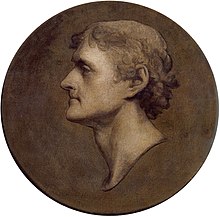Jeffersonian Republicans | |
|---|---|
| Historical leaders | Thomas Jefferson James Madison James Monroe |
| Founded | 1790s |
| Dissolved | 1820s |
| Merged into | Democratic-Republican Party |
| Succeeded by | Jacksonian Democrats |
| Ideology | Agrarianism[1] American nationalism Anti-clericalism[2] Classical liberalism[3] Populism[4] Radicalism Republicanism[5] |
| Political position | Left-wing[6][7] |
| National affiliation | Anti-Federalists (before 1789) Anti-Administration party (1789–1792) Democratic-Republican Party (after 1792) |
| Colors | Green |
| Jeffersonian Era | |||
|---|---|---|---|
| 1801–1825 | |||
 The 1805 Jefferson medallion portrait by Gilbert Stuart | |||
| Location | United States | ||
| President(s) | Thomas Jefferson James Madison James Monroe | ||
| Key events | Louisiana Purchase Lewis and Clark Expedition Marbury v. Madison War of 1812 | ||
Chronology
| |||
Jeffersonian democracy, named after its advocate Thomas Jefferson, was one of two dominant political outlooks and movements in the United States from the 1790s to the 1820s. The Jeffersonians were deeply committed to American republicanism, which meant opposition to what they considered to be artificial aristocracy, opposition to corruption, and insistence on virtue, with a priority for the "yeoman farmer", "planters", and the "plain folk".[4] They were antagonistic to the aristocratic elitism of merchants, bankers, and manufacturers, distrusted factory workers, and strongly opposed and were on the watch for supporters of the Westminster system.
The term was commonly used to refer to the Democratic-Republican Party, formally named the "Republican Party", which Jefferson founded in opposition to the Federalist Party of Alexander Hamilton. At the beginning of the Jeffersonian era, only two states, Vermont and Kentucky, established universal white male suffrage by abolishing property requirements. But by the end of the Jeffersonian period, more than half of the states had followed suit, including virtually all of the states in the Old Northwest. States then moved on to allowing white male popular votes for presidential elections, canvassing voters more modernly. Jefferson's party was then in full control of the apparatus of government – from the state legislature and city hall to the White House.
Jeffersonian democracy persisted as an element of the Democratic Party until the early 20th century, exemplified in the rise of Jacksonian democracy and the three presidential candidacies of William Jennings Bryan.
- ^ Ohio History Connection. "Democratic-Republican Party". Ohio History Central. Archived from the original on December 29, 2021. Retrieved August 30, 2017.
Democratic-Republicans favored keeping the U.S. economy based on agriculture and said that the U.S. should serve as the agricultural provider for the rest of the world ... . Economically, the Democratic-Republicans wanted to remain a predominantly agricultural nation, ... .
- ^ Beasley, James R. (1972). "Emerging Republicanism and the Standing Order: The Appropriation Act Controversy in Connecticut, 1793 to 1795". The William and Mary Quarterly. 29 (4): 604. doi:10.2307/1917394. JSTOR 1917394.
- ^ Adams, Ian (2001). Political Ideology Today (reprinted, revised ed.). Manchester: Manchester University Press. p. 32. ISBN 978-0719060205. Archived from the original on 2023-01-20. Retrieved 2021-12-01.
Ideologically, all US parties are liberal and always have been. Essentially they espouse classical liberalism, that is a form of democratized Whig constitutionalism plus the free market. The point of difference comes with the influence of social liberalism.
- ^ a b Wood, The American Revolution, p. 100
- ^ "Democratic-Republican Party". Encyclopædia Britannica. July 20, 1998. Archived from the original on June 15, 2018. Retrieved August 30, 2017.
The Republicans contended that the Federalists harboured aristocratic attitudes and that their policies placed too much power in the central government and tended to benefit the affluent at the expense of the common man.
- ^ Ornstein, Allan (2007). Class Counts: Education, Inequality, and the Shrinking Middle Class. Rowman & Littlefield Publishers. pp. 56–58. ISBN 978-0742573727. Archived from the original on 2023-01-20. Retrieved 2021-12-01.
- ^ Larson, Edward J. (2007). A Magnificent Catastrophe: The Tumultuous Election of 1800, America's First Presidential Campaign. Simon and Schuster. p. 21. ISBN 978-0743293174. Archived from the original on 2023-01-20. Retrieved 2021-12-01.
The divisions between Adams and Jefferson were exasperated by the more extreme views expressed by some of their partisans, particularly the High Federalists led by Hamilton on what was becoming known as the political right, and the democratic wing of the Republican Party on the left, associated with New York Governor George Clinton and Pennsylvania legislator Albert Gallatin, among others.